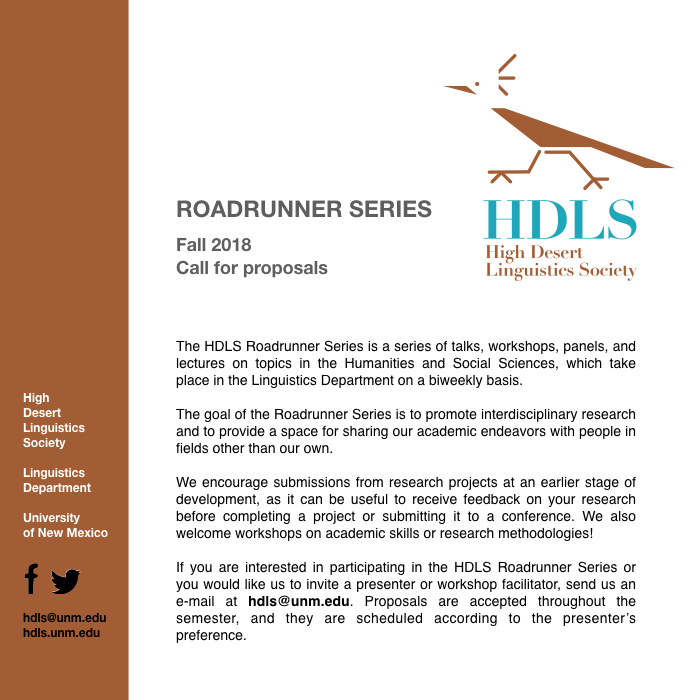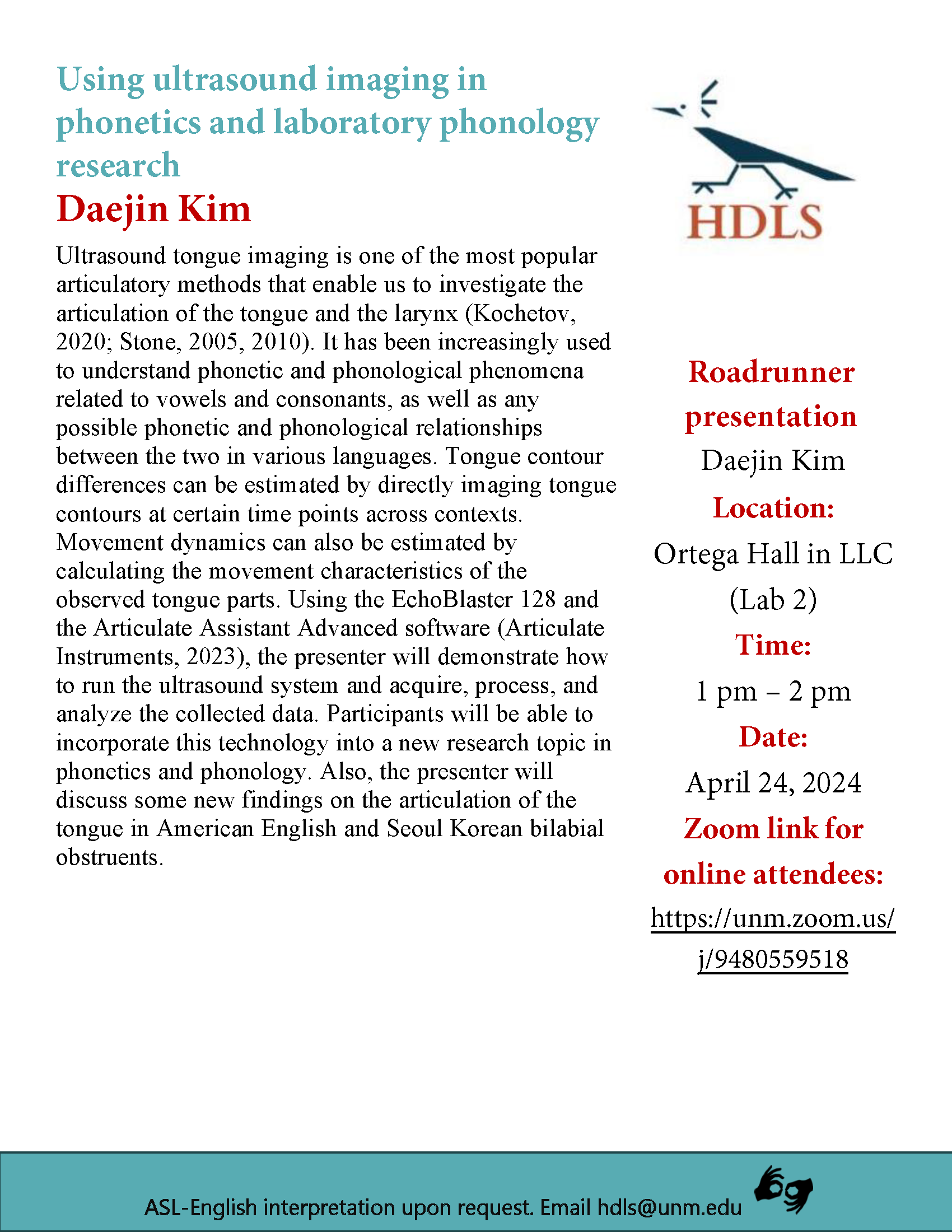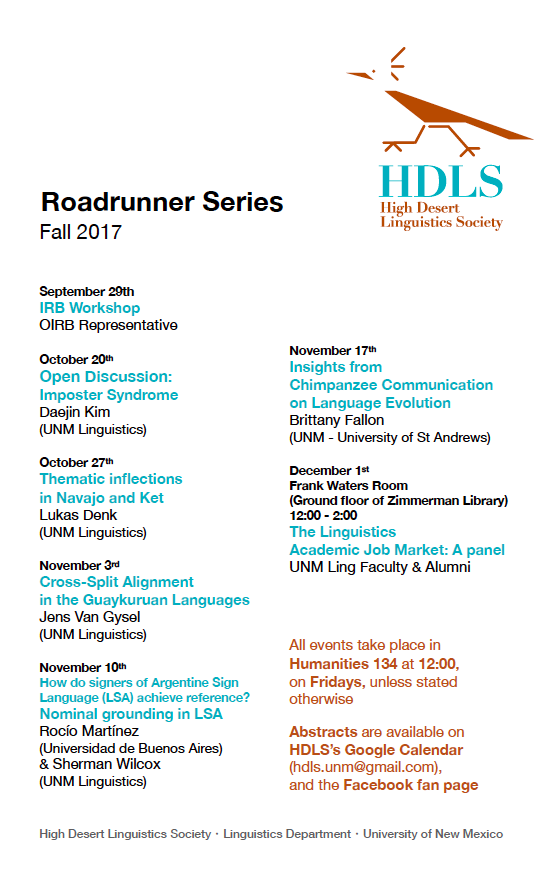Past Roadrunner Series
Spring 2024
Traditional forms of speech adaptation for distance communication and musical surrogacy
Julien Meyers, PhD
The High Desert Linguistics Society is proud to host Julien Meyer, PhD, a renowned expert on whistled languages. Dr. Meyer's work is associated with the French National Center for Scientific Research. He will be in New Mexico to speak at the Santa Fe Institute and so we are capitalizing on the opportunity to also have him here at UNM!
Dr. Meyer has published the book Whistled Languages:
A Worldwide Inquiry on Human Whistled Speech, in addition to numerous journal articles and other publications.
Here are some examples, with intriguing titles!
- Meyer, J., Magnasco, M.O., & Reiss, D. (2021). The relevance of human whistled languages for the analysis and decoding of dolphin communication. Frontiers in Psychology, 12, https://doi.org/10.3389/ fpsyg.2021.689501.
- Meyer, J. (2021). Environmental and linguistic typology of whistled languages. Annual Review of Linguistics, 7, 493-510.
- Meyer, J. (2008). Typology and acoustic strategies of whistled languages: phonetic comparison and perceptual cues of whistled vowels., 38, 69-94.
Re-Evaluating the Role of Ease of Articulation: Analyzing Handshape Distribution in Taiwan Sign Language
Devin Tankersley
This study examines handshape distribution in Taiwan Sign Language (TSL) naturalistic discourse across two metrics: type frequency using a corpus of signs compiled across six pedagogical sources and Ann’s (2005) ease of articulation categories. Ann posits a correlation between ease of articulation of a given handshape and its distributional frequency in naturalistic discourse, with more easily produced forms occurring more frequently. This study expands on her original analysis by building a larger corpus of conversational data and by widening the scope of the lexicon under investigation with an expanded data set across more sources, totaling 2000 lemmas. By increasing the corpus size, as well as diversifying discussion topics beyond a single conversation, this study is able to conduct statistical analyses more capable of achieving valid results, as well as mitigate confounds of overrepresentation of certain handshapes due to their morphosemantic content. Moreover, this study assesses the role of ease of articulation in understanding asymmetries in changes between handshapes, finding that starting from type frequency may offer additional insights to understanding how ease of articulation functions in the signed modality.
The auxiliary construction in Present-day English
Ana Flávia Matos Freire
January 24th, 2024 (1-2p, LLC Lab #2)
Shoulda, coulda and woulda are emergent auxiliary verbs understood as contracted forms from should have, could have and would have, respectively. Having as hypothesis that these verbs express more than, and are used to mark tense, aspect and modality (TAM), this research aims to analyze the uses of shoulda, coulda and woulda in Present-day English (PDE) under a constructionist approach. For this, I rely on Goldberg (1995), Croft (2001), Traugott and Trousdale (2013) and Furtado da Cunha, Bispo and Silva (2013) with respect to the formal and functional properties of a construction, to the properties of schematicity, productivity and compositionality and to the characterization of constructional network; Heine (1993) and Bybee (2010) regarding the notion of auxiliary verbs and the development of modern auxiliaries and modals; and Lyons (1977), Palmer (1986) and Croft (2012) to the comprehension of the categories of modality and aspect. In order to establish an analysis within real communication situations, I use the Corpus of Contemporary American English (COCA), formed by eight text groups, namely, oral, fiction, magazines, newspapers, academic, blogs, webpages and TV/movies from 1990 to 2019. To process the data, I use WordSmith Tools 7.0 program. The idea is to measure token and type frequency, and verify the contexts of occurrences and their functions, and with that, to describe the place of shoulda, coulda and woulda, as auxiliary verbs, on the constructional network.
Fall 2018
- Dr. Anna M. Trester (Career Linguist). Bringing Linguistics to Work. [7 September 2018]. Details, here.
- Sara Siyavoshi and Dr. Sherman Wilcox (UNM Linguistics). The Puzzle of the Horseshoe Mouth: A Polysemous, Multifunctional Facial Display. [12 September 2018]. Details, here.

Spring 2018
- Dr. Ian Maddieson (UC Berkeley/UNM Linguistics). Language adapts to environment. [24 January 2018]. Video available here.
- Carlos Enrique Ibarra (UNM Spanish & Portuguese). Spanglish in Intermediate-Advanced Heritage Language Students: Attitudes and Production. [2 March 2018]. Video available here.
- Andrés Sabogal (UNM Linguistics). Possession Constructions in Wayuunaiki. [9 March 2018]. Video available here.
- Dr. Jason Timm (UNM Linguistics). R Workshop for Ling Grads. [23 & 30 March 2018]. Abstract available here.
- Dr. Caroline Smith (UNM Linguistics). Articulatory correlates of prominence in French: Comparing L1 and L2 speakers. [2 April 2018]. Abstract available here.
- Dr. Rebecca Blum-Martínez (UNM Language, Literacy, and Sociocultural Studies). Bilingual Education in New Mexico [6 April 2018]. Abstract available here.
- Yuliana Kenfield (UNM Language, Literacy, and Sociocultural Studies). Decolonial Gestures of bilingual Quechua-Spanish college students towards language ideologies. [20 April 2018]. Video available here.


